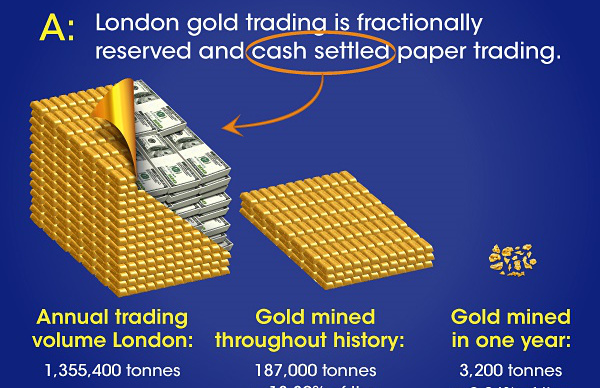Mining
An Inside Look at the World’s Biggest Paper Gold Market
Every day, there are a whopping 5,500 tonnes ($212 billion) of gold traded in London, making it the largest wholesale and over-the-counter (OTC) market for gold in the world.
To put that in perspective, more gold is traded in London each day than what is stored at Fort Knox (4,176 tonnes). On a higher volume day, amounts closer to total U.S. gold reserves (8,133.5 tonnes) can change hands.
How is this possible?
The infographic below tells the story about gold’s foremost trading hub, as well as the paper gold market in London, England:

Image courtesy of: BullionStar
London is dominant in global price discovery for gold.
In 2015, it accounted for roughly 88% of gold trade – most of which occurs between banks on behalf of their clients. Further, 90% of London trade is spot trading, which further emphasizes London’s importance in price discovery for gold markets.
While the high-level details of the market are visible, the individual mechanisms behind the London gold trade are less clear. There is very little detailed information provided on physical shipments, outstanding gold deposits or loans, allocated or unallocated gold, or clientele types. Trade reporting also breaks down at a more granular level, and datasets on the GOFO (Gold Forward Offered Rate) were also discontinued in January, 2015.
Almost all gold (95%) traded in London is unallocated and without legal title. This makes it easier to trade, but it also raises concerns about a market that is opaque to begin with. There are 5,500 tonnes of paper gold exchanging hands on paper each day, but there are only 300 tonnes of gold vaulted in London outside of the reserves for ETFs or the Bank of England.
What would happen if there was ever even a small rush to get the physical asset behind the paper? Is there a system in place for such an event, and how does it work?
Original graphic by: BullionStar
Lithium
Ranked: The Top 10 EV Battery Manufacturers in 2023
Asia dominates this ranking of the world’s largest EV battery manufacturers in 2023.

The Top 10 EV Battery Manufacturers in 2023
This was originally posted on our Voronoi app. Download the app for free on iOS or Android and discover incredible data-driven charts from a variety of trusted sources.
Despite efforts from the U.S. and EU to secure local domestic supply, all major EV battery manufacturers remain based in Asia.
In this graphic we rank the top 10 EV battery manufacturers by total battery deployment (measured in megawatt-hours) in 2023. The data is from EV Volumes.
Chinese Dominance
Contemporary Amperex Technology Co. Limited (CATL) has swiftly risen in less than a decade to claim the title of the largest global battery group.
The Chinese company now has a 34% share of the market and supplies batteries to a range of made-in-China vehicles, including the Tesla Model Y, SAIC’s MG4/Mulan, and various Li Auto models.
| Company | Country | 2023 Production (megawatt-hour) | Share of Total Production |
|---|---|---|---|
| CATL | 🇨🇳 China | 242,700 | 34% |
| BYD | 🇨🇳 China | 115,917 | 16% |
| LG Energy Solution | 🇰🇷 Korea | 108,487 | 15% |
| Panasonic | 🇯🇵 Japan | 56,560 | 8% |
| SK On | 🇰🇷 Korea | 40,711 | 6% |
| Samsung SDI | 🇰🇷 Korea | 35,703 | 5% |
| CALB | 🇨🇳 China | 23,493 | 3% |
| Farasis Energy | 🇨🇳 China | 16,527 | 2% |
| Envision AESC | 🇨🇳 China | 8,342 | 1% |
| Sunwoda | 🇨🇳 China | 6,979 | 1% |
| Other | - | 56,040 | 8% |
In 2023, BYD surpassed LG Energy Solution to claim second place. This was driven by demand from its own models and growth in third-party deals, including providing batteries for the made-in-Germany Tesla Model Y, Toyota bZ3, Changan UNI-V, Venucia V-Online, as well as several Haval and FAW models.
The top three battery makers (CATL, BYD, LG) collectively account for two-thirds (66%) of total battery deployment.
Once a leader in the EV battery business, Panasonic now holds the fourth position with an 8% market share, down from 9% last year. With its main client, Tesla, now sourcing batteries from multiple suppliers, the Japanese battery maker seems to be losing its competitive edge in the industry.
Overall, the global EV battery market size is projected to grow from $49 billion in 2022 to $98 billion by 2029, according to Fortune Business Insights.
-

 Markets1 week ago
Markets1 week agoRanked: The Largest U.S. Corporations by Number of Employees
-

 Green3 weeks ago
Green3 weeks agoRanked: Top Countries by Total Forest Loss Since 2001
-

 Money2 weeks ago
Money2 weeks agoWhere Does One U.S. Tax Dollar Go?
-

 Automotive2 weeks ago
Automotive2 weeks agoAlmost Every EV Stock is Down After Q1 2024
-

 AI2 weeks ago
AI2 weeks agoThe Stock Performance of U.S. Chipmakers So Far in 2024
-

 Markets2 weeks ago
Markets2 weeks agoCharted: Big Four Market Share by S&P 500 Audits
-

 Real Estate2 weeks ago
Real Estate2 weeks agoRanked: The Most Valuable Housing Markets in America
-

 Money2 weeks ago
Money2 weeks agoWhich States Have the Highest Minimum Wage in America?














